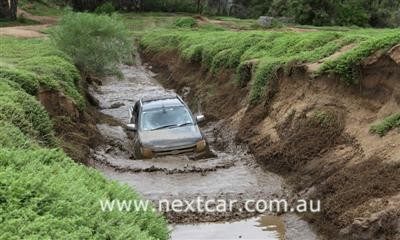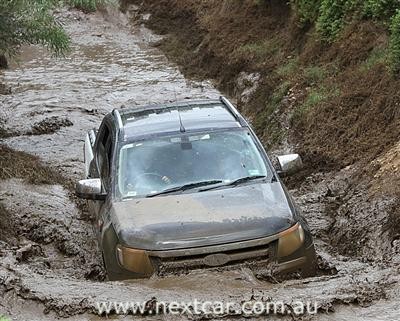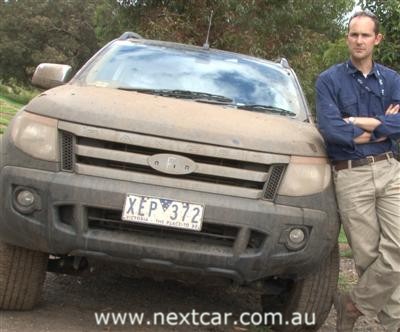Ford test the new Ranger off-road
|


 Ford's vehicle integration engineer Sam Ellis (above)
Ford's vehicle integration engineer Sam Ellis (above)
|
|
|
Home >
News >
Ford
17th April, 2011
- Ranger boasts outstanding ground clearance of up to 241 mm and class-leading water-wading
capability of 800 mm
- Ranger easily goes up and downhill using a range of technologies in the Electronic Stability
Programme such as Hill Launch Assist, Hill Descent Control and Roll-over Mitigation
- Ranger makes available an electronic locking rear differential that “locks” both the rear wheels
together so that they turn together at the same speed, proving more traction control
Ford suggest their latest global compact utility is as calm and composed off the beaten track as
on sealed roads thanks to an all-new chassis frame, front and rear suspension and steering system.
With a claimed best-in-class water-wading capability of 800 mm and a ground clearance of up to 241
mm, the all-new Ford Ranger has turned into a lean, mean driving machine.
Increasingly, Ranger caters not only to the mining or forestry companies which require a tough
utility to handle off-road driving situations but also to customers who enjoy off-roading for
recreation. Other customers drive off-road because their hobbies demand it, say, if they were to go
fishing, mountain bike riding, bushwalking or camping.
“These customers are looking for a vehicle that’s capable enough to take them further afield
into more remote locations,” said vehicle integration engineer Sam Ellis. “And we’ve
engineered the Ranger to be able to do this and more.”
Climb every mountain
One characteristic that sets Ranger apart from competitors is its capability on steep grades. A
fully-laden Ranger, which weighs about 3,200 kg, is also able to stop and then pull away on a 60%
grade – not a feat easily achieved by most trucks. Ranger’s capability is further enhanced by a
suite of technologies that is part of the new-to-Ranger Electronic Stability Programme (ESP) such as
Hill Launch Assist, Hill Descent Control and Roll-over Mitigation.
Hill Launch Assist assists the driver when moving off up a slope, either in forward or reverse
gear. When the driver releases the brake pedal and starts to accelerate to drive away, the feature
holds the brake pressure temporarily for 2 seconds, ensuring the vehicle does not roll back,
allowing the driver to pull away smoothly.
When going downhill either in forward or reverse gear, the driver can activate Hill Descent
Control via a button on the dashboard for steadier braking. The feature automatically applies the
brakes to slow the vehicle down to a set speed without locking the brakes and without the need for
the driver to apply the brakes.
If the Ranger is going too slowly, he or she can allow the vehicle to go faster by squeezing the
accelerator or using the speed up or speed down buttons on the cruise control buttons. This is
unlike competitors with a similar feature where the set downhill speed cannot be changed and is
available only with four-wheel drive low-gearing. In comparison, Ranger’s Hill Descent Control
feature is available on both high- and low-gearing, giving the Ranger better composure and the
driver greater confidence in going down a steep slope.
To give the driver further peace of mind, Ranger has a Roll-over Mitigation safety feature that
closely monitors the vehicle's speed, lateral acceleration, yaw motion and steering angle, and will
identify potentially dangerous driving conditions that would lead to the vehicle rolling over.
Well before the situation becomes critical, it will cause the ESP system to intervene and control
the vehicle speed and restore stability.
“Composure describes how comfortably and easily a vehicle tackles difficult obstacles and
terrains,” explained Ellis. “If a vehicle is composed, you don’t have to charge at an
obstacle to get over it or rush through things to get past difficult terrain.”
“This allows the vehicle to be driven in a more controlled manner. It’s more relaxing for the
driver and reduces the risk of damaging the vehicle. So composure was a very important attribute
that we built into Ranger’s off-road capability.”
Built Ford Tough
To give Ranger its outstanding ground clearance and class-leading water-wading capability, the
engineers found innovative solutions to tuck key components out of harm’s way, from placing them
higher up in the vehicle to finding clever locations for them so that they don’t become damaged if
the ute hits the ground or a rock.
For example, the fuel tank is higher than the frame, which means it will never bottom out (on a
flat surface). Driveline components are mounted above the frame rail so that items like the transfer
case and oil pan are protected by strong crossmembers. Key electrical components and air inlets are
also strategically placed high in the engine compartment, enabling the pickup to go deeper than any
others.
Ranger gets another level of protection through shields on vulnerable components. A shield on
the fuel tank of 4x4 models, as well as a steel shield at the front of the vehicle, protects the
front of the engine and the radiator. Engineers managed to double the strength of the front shield
without making it heavier and it’s been tested that just the shield alone is able to bear the front
axle weight of the vehicle.
Gaining traction
The four-wheel drive models are equipped with a sturdy electronically controlled transfer case –
for both manual and automatic transmissions – that allow drivers to shift on the fly from 4x2 to
4x4 anytime via a switch conveniently located on the console.
Low-range gearing can be enabled for extra torque or additional downhill braking and the Ranger
offers lower overall ratios for improved off-road capability. When the low-range gears are engaged,
the driver gains more control with the damped accelerator pedal which becomes less sensitive. This
prevents unintentional acceleration due to the bouncing motion of the driver’s foot while moving
over bumpy ground.
The Ford Ranger's ESP system also includes off-road logic which recognises when the ute is
driven on rough roads and modifies the system to ensure the best balance between stability and
timeliness of interventions. In 4x4 models, the ESP system can be partially switched off to disable
over- and under-steer control as well as engine torque reductions, while maintaining the brake
intervention traction control. This setting is most suitable when driving through deep sand or
extreme mud as vehicle momentum can be maintained whilst maximising available grip. The ESP can be
switched to a second setting to further amend the ESP braking intervention that aids the initial
pull away in snow and icy conditions.
For customers who need more traction control, a limited slip rear differential or an electronic
locking rear differential is available as an option. With the limited slip rear differential, power
is maintained to both wheels when one of the wheels begins to slip.
A new feature on Ranger, the locking rear differential is activated by pressing a button on the
dashboard. This engages a locking device through a clutch on the rear axle to “lock” both the rear
wheels together so that they turn together at the same speed. This is extremely useful if one of
the rear wheels loses traction completely because it is on ice, mud or lifted up in the air.
Without a locking device, that wheel would spin up and all the engine power and torque would go
to that wheel. But if the wheels are “locked” together, the wheel with traction gets enough power
and torque to enable the vehicle to move forward even under challenging conditions.
“The all-new Ford Ranger is a very capable off-road vehicle and anyone can drive it with an
incredible amount of composure,” said Ellis. “Because it’s so intuitive in communicating
with you and giving you good feedback through the steering and the seats, you’re able to make clear
decisions and feel confident and safe while driving in tough terrains.”
Driving tips for off-road adventures
Off-road driving does not have to be a dangerous adventure, Sam Ellis gives his top tips on how
to remain safe while going off the less travelled path.
1. Tyre pressure
When going into muddy or sandy terrain, or terrain that has large rocks, it’s good to lower the
tyre pressure. Lowering the tyre pressure will increase the amount of tyre that contacts the road
surface, called the contact patch. The larger the contact patch, the more grip, the more traction
you will have.
Sandy ground requires you to take the most air out of the tyres, but don’t go below 16 PSI. The
lower the tyre pressure, the higher the risk of the tyre coming off the rim. For other conditions,
taking 3 or 4 PSI out of the tyre pressure should be enough to give you the additional traction
that you need.
2. Make sure you have sufficient and suitable recovery gear
You’ll need items such as snatch straps and rated shackles. It’s important that they are rated
so that you know they’re going to be strong enough to withstand the forces of a snatch recovery.
Ranger has snatch recovery points that are rated to 6,400 kg. So your shackles should be rated to
6,400 kg or more.
|
|
|

Self-Catering Holiday
Accommodation in
Denmark, WA
..... more
|
|
|
3. Understand what the road is like up ahead
By keeping an eye on the road, not just immediately ahead but further down too, you can select
the appropriate gear or drive modes beforehand to ensure you have the correct engine torque, engine
speed and vehicle speed before having to attempt a difficult manoeuvre.
And if you’re coming up to a deep puddle, deep bog or a steep sand dune, it’s always best to go
cautiously first. If possible, get out and walk around to have a look to avoid nasty surprises.
Once you know what’s there, you can negotiate it in the safest and most composed way.
4. Check the depth when going through deep water
If it’s safe to do so, get out of the vehicle and walk through the deep water before driving
through. While testing the water depth, also get an understanding of what the ground is like under
the water. Is it deep and muddy, or rocky with little holes everywhere? It might be shallow in one
part and deep in another. You can then figure out the best path through the water.
When driving through deep water, it’s important to maintain a slow and steady pace and not stop.
Maintaining a steady pace will keep the pressure up in the transmission and the differentials,
which will stop water coming into the differentials. Ranger has breather tubes on the transmission
and the differentials to stop water coming in, but if the car is stopped, there’s always a
possibility that the water will find its way in.
5. Know what the lowest part of your vehicle is, especially the differentials
Look under the vehicle and know how it’s constructed. You need to know what your car is capable
of and what the lowest part is. If you can hear something starting to scrape while driving over
rough roads, you can decide if it’s safe to proceed because you have a good idea of which part of
the car will be affected.
When going over ruts or rocks, one way to improve ground clearance is to drive one wheel up onto
a rock and it will raise the vehicle up as well. If you keep the vehicle up high, it will avoid
striking anything beneath it.
6. Always keep both hands on the steering wheel
When driving on rough roads, the wheels can sometimes hit a rut or a rock, causing the steering
wheel to spin around. If you’re not holding the steering wheel with both hands, you might lose
control of the vehicle. Also make sure your thumbs are not in the steering wheel so that they don’t
get hit by the steering wheel arm when it spins. Things like that can happen unexpectedly, so you
need to be ready for that by keeping hands on the wheel and thumbs out.
|